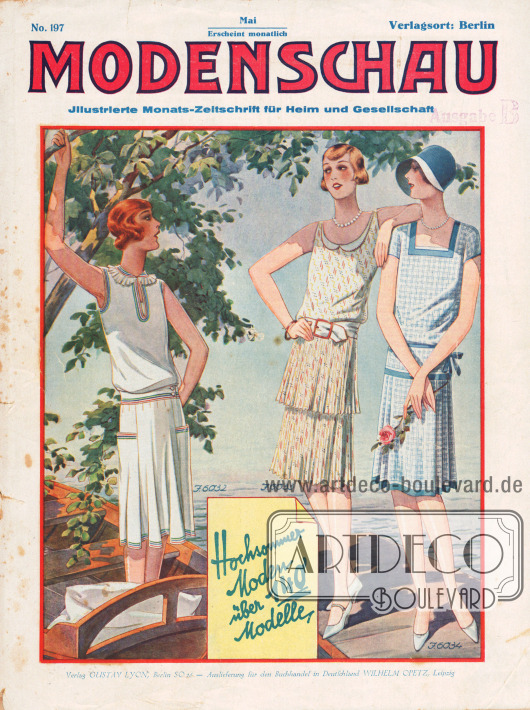|
|
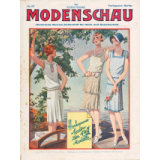
|
Title page or front cover of the German fashion magazine Modenschau (Eng. title: Fashion Show, subtitle: Illustrated Monthly Magazine for Home and Society) no. 197 for Mai 1929.
Midsummer fashions over 140 models.
Description of the colored cover page.
J 6032. Summery dress made of wash silk with different colored ribbon trim. Flounce at the collar. Fabric usage: 2.90 m 100 cm wide. Pattern size 44 and 48. Price 1 mark.
J 6033. Youthful dress made of finely patterned wool muslin. The skirt consists of two pleated flounces. Decorative stitching on the collar and belt made of plain-colored material. Fabric usage: 4.60 m 80 cm wide. Pattern size 42 and 44. Price 1 mark.
J 6034. Simple dress made of blue and white checked artificial silk, trimmed with blue and white panels. Tie belt. The skirt is extended by groups of pleats at the sides. Fabric usage: 2.60 m checked, 0.40 m blue, each 80 cm wide. Pattern size 44 and 48. Price 1 mark.
[Stamp:] Issue B [probably issue for subscribers].
May. Published monthly.
Place of publication: Berlin.
Publishing house Gustav Lyon, Berlin SO 16 — Distribution for the book trade in Germany Wilhelm Opetz, Leipzig.
Title illustration/title drawing: unknown/unsigned.
|
|
|
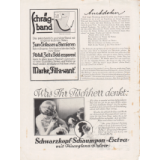
|
Article:
N. N., Anecdotes.
Advertising:
Bias tape. F.a.W. Deposited trademark. The patent-protected tape with diagonally running threads. No more tedious bias cutting of the fabric for edging & garnishing, thus saving waste, time & money. Can be bought by the meter in many qualities, colors and widths in any better store. Bias tape A.-G., Basel, Switzerland. Brand 'Fill-a-want'.
What your host thinks: "How beautiful she looks with her fragrant, loose hair and how well the deep waves suit her with their radiant shine!" And you will immediately notice from the warmer tone of the conversation how much beautiful hair can do… So wash your hair every week with "Schwarzkopf Schaumpon-Extra" and give it extra shine by rinsing it with hair shine powder. The marcelling also becomes more beautiful and more durable. The original green pack of "Schwarzkopf Schaumpon-Extra" with free hair shine powder costs 30 pf. — Schwarzkopf hair shine powder in a special pack of 4 sachets costs 50 pf. Schwarzkopf Shampoo =Extra= with hair shine powder. Photo: "Yva" (Else Ernestine Neulaender-Simon, 1900-1942).
|
|
P. 1 |
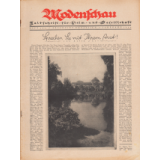
|
Title page or cover of the Modenschau (Eng. title: Fashion Show, subtitle: magazine for home and society) no. 197 for May 1929.
Article:
Sell, Anita, Talk to Your Doctor! (by Anita Sell, unknown author).
In the center of the page is a large-format black and white photograph with the caption "In beautiful Wiesbaden: The Kurhaus with the pond". Photo: unknown/unsigned.
[Sell, Anita, Talk to Your Doctor!]
Ladies! Believe everything your best friend says, even that your hat from last year looks fabulous on you and is exactly in this year's fashion, but please: never believe her when it's about a trip to the spa! Let's just admit it between ourselves: we women are by no means as perfect as we would like to make the so-called stronger sex believe — our bodies are a bit off here and there, our nerves no longer want to parry, in short, we have the feeling that we are in need of a bit of repair. And just now, when the world is looking at us a little more kindly again after the eerily endless winter, perhaps it would not be unreasonable to seriously tackle this repair of our worthy selves? Recognition is the first step towards improvement, if — the second leads you to the doctor, ladies. Communicative as we are, we tell our best friend(s) what is bothering us in a harmless manner and — yes, all of a sudden the friend is gripped by well-intentioned helpfulness and gives us advice! Play Ulysses, ladies, and close your ears to such siren sounds: really, it proves nothing for your condition that Mrs. X. or Miss Y. also got palpitations after the third cup of coffee and was able to break the world record in coffee drinking last year after a cure in Zetdorf! That's why this certainly very beautiful Zetdorf is far from being the right seaside resort for you! After all, your good friends are not the right advisors on medical matters, and your palpitations may have a thousand other reasons than those of dear Mrs. X. So: talk to your doctor and have a spa trip prescribed for you. This scholarly man will first give you a thorough examination and use all the tools of modern science to investigate the cause of your undesirable condition. He calls this "diagnosis" and sees it as the be-all and end-all of all medicine. If he now murmurs to you with a friendly smile "A little disorder in the liver, in the heart…" (it could also be any other organ), then it is advisable not to run straight from his consultation to the nearest travel agency and ask for brochures of all the spas and health resorts that are particularly beneficial for the heart or liver. … (end on page 14).
[Page] 1
|
|
P. 2 |
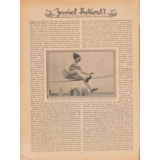
|
Article:
Wedekind-Pariselle, Anna P., Too Much Record? (by Anna P. Wedekind-Pariselle, biographical data unknown).
In the center of the page is a photograph showing a pole-vaulter in flight. The caption reads "The beautiful Miss Catherwood [Ethel Hannah Catherwood, 1908-1987] beaming as she breaks the world record in the high jump for Canada. (Photo Schirner)."
Photo: Schirner (sports photographer Max Schirner, 1891-1952).
[Wedekind-Pariselle, Anna P., Too Much Record?]
Olympic Games Amsterdam 1928: Three women bring Germany Olympic honors, three times the imperial colors go up, announcing the highest sporting triumph, Olympic victory — women. Victory — for the thrilled and amazed world! And yet it is precisely the victory of one of them, the very likeable Ms. Radtke-Batschauer, that is the reason for the liveliest exchange of opinions between the sports experts and specialists present, while storms of jubilation are still roaring through the stadium. It is not about her athletic performance; the unique run of this young mother of two children, who ran the 800 m in 2:16.4 minutes — a time that would have been a challenge even for men! — stands above any discussion. But the others who ran with her over this incredibly difficult distance and exhausted themselves to the point of complete exhaustion gave many a serious athlete pause for thought. Certainly, they too wanted to fight for victory for their homeland! But can one still approve of this endeavor in view of the excessive effort? It was precisely from the mouths of the best German sportsmen that one heard a "No! We don't want to see our women suffer like that! Draw a line between women's and men's sport: you can see the boundaries!" And so we thank the young Mrs. Radtke not only for the Olympic honors, the world record, the proof that motherhood and high athletic ability are compatible, but also perhaps indirectly for a sensible return to the camp of the sports associations and clubs.
Women's sport has achieved wonderful things in a very short space of time, if you let the figures speak for themselves. Girls' gymnastics was first introduced in 1851 by the gymnastics teacher Kluge, the first women's gymnastics club was founded in Frankfurt am Main in 1889, but it was not until 1894 that gymnastics became a compulsory subject at secondary schools. And it took until 1919 for the leading athletics clubs to form women's sections! So up to this point, skill exercises, gymnastic agility, only now training for athletic combat with the ultimate goal: records! — Anyone who, like me, was able to help develop one of the largest women's sports departments in Germany knows best what joys the sports field opened up for our female youth. It was really something different from the school gym class, this rain and exercise in the fresh air, in sensibly light sportswear. It was only now that we learned to use our limbs properly, to consciously control the play of our muscles! I still remember today how I started my first run on the cinder track in March 1919: elbows pressed tightly against my body, fists in front, just as we had learned in gym class. I hoped to be praised for running so well and was laughed at! I had to relearn from scratch: "Your arms are for walking too!" And what a joy it was to realize how arms and legs work together to inspire running. Ambition and a desire to fight immediately arose — the first races were held between us, the hunt for tenths of a second began and the stopwatch became the most coveted item. Nobody thought of taming our competitive zeal! It spurred us on to new, ever better performances, and the club needed them. Every major athletics club now had a women's section, and everyone wanted their ladies to be at the forefront of the newly established women's sport. The best athletes trained tirelessly with their new female comrades, whose enthusiasm never waned but grew. We won our first victories, beaming and laughing — despite the years of war behind us, our bodies were still so fresh and unused, not at all tired or over trained! We were happy, healthy people who were committed to something new that was worth the effort of our whole personality. How we were treated with hostility and ridicule, often in our own home, because the sight of the new, functional sportswear, the bare legs that were not restricted by stockings and garters, was so unfamiliar! My mother was beside herself when she saw me competing in the first big relay race, the traditional Potsdam — Berlin, now also conquered by women. But what did all this matter to us? We felt like pioneers and — after all — we were! What do today's young people, the generation that has grown up with completely different views, know about these battles that took place in the domestic circle around the "hours in the air and sun"? Happy youth of today, for whom sporting activity has become a matter of course! Or — not as happy as we once were? You almost want to believe it when you see the tense, distorted faces of today's winners. The hunt for the record eats up their joy of sport itself! For them, sport is only expressed in numbers, in the times they achieve, in the centimeters they jump. Only a few win with such beauty as the young Canadian Miss Catherwood, to whom all hearts flew at the Olympics, only a very select few as calmly superior, as full of determined energy as Ms. Radtke. The majority — this must be said even at the risk of many hostile creations — no longer offer an aesthetic sight during the fight. Is it due to the competitions themselves, which place too many demands on women's bodies? Is it due to the personal ambition of the fighters, who know no rest and relaxation during training and therefore become more nervous and passionate than is good, or is it due to the clubs, which of course have to put out the guns "for advertising reasons" and sometimes do too much of a good thing? That should and must be decided by those more qualified! … [continued on page 3].
[Page] 2
|
|
P. 3 |
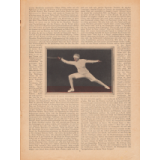
|
Article:
Wedekind-Pariselle, Anna P., Too Much Record? (by Anna P. Wedekind-Pariselle, biographical data unknown).
In the center of the page is a photograph showing a female fencer doing a lunge while fencing. The caption reads "Helene Meyer, the graceful seventeen-year-old, won Olympic honors for Germany in 1928 (Photo: Schirner)."
Photo: Schirner (sports photographer Max Schirner, 1891-1952).
[Wedekind-Pariselle, Anna P., Too Much Record?]
[Continued from page 2] … My lines are only a warning to all those who enjoy air and exercise: "Do sport, you women, but beware of excessive sport!" Remember that you women in particular have a duty to the whole nation: your bodies must be healthy and fit so that the next generation can be even healthier, even more fit, even more cheerful! This duty is higher than the pursuit of records. A record is only ever a success for the individual, the result of a special talent that recognizes the limits set by the body and can achieve exceptional performances without complete exhaustion. The others, the large number of average talents, should refrain from fruitless record chasing and rather seek the joy of life and the growth of strength in sport. This is there for everyone who strives to find it! Healthy sport — and that is any sporting activity that is not exaggerated — not only strengthens the body, but also trains the mind: it demands determination and presence of mind from people (I am thinking of all the famous sports games), it creates the best bond that can unite people: comradeship ready for action! Today, healthy sport is a necessity for working women, who have to work all day in what is usually stuffy air, and is the best counterbalance to the sedentary work to which our women and girls are often forced by economic circumstances. I define "sport" here in the broadest sense, meaning everything that involves physical activity away from work: gymnastics, athletics, exercises, swimming, rowing, canoeing, field hockey, handball, ice skating and skiing, tobogganing, tennis, golf and fencing. If everyone chooses what gives them the most pleasure, they will soon find the inner satisfaction that healthy people need so that a healthy mind can live in a healthy body. Then the joy and health that is the better path to beauty than strength will once again live on their faces. But away with the addiction to records, which is so often driven by vanity rather than the joy of achievement. Records should be left to those for whom nature and talent have created the necessary preconditions. Don't give the spectacle of distorted, unfemininely exaggerated efforts, which must only earn the only ten-year-old women's sport head-shaking rejection instead of the necessary supporters. Believe me: it only works — without too many records! Of course, this is not intended to reject any measurement of strength. Of course you want to test your skills against the achievements of others, you want to find out whether and what you have learned or not. That is human and should not even be seen as a small weakness. It is up to the clubs, up to the sports administrators, to ensure that this "peaceful" battle of average sportswomen, of average talents, remains within the right limits. In this respect, very pleasing results can already be seen on many sports fields. Perhaps a comparison with modern schools is justified? In the past, there were monthly grades, changing places every first — in other words, a battle of zeal, joy (and of course vanity! No less ambitious parents fueled it: "You're not going to come down, are you? I don't want to see Lotte H. getting your third place!") So certainly an incentive! But it also works without it, as the results of today's school education prove: in many cases, there is no more "sitting down" and only very few grades are awarded. Nevertheless, the same achievements, the same joy in learning, which insightful teachers know how to increase cleverly and imperceptibly! The unpleasant picture is rarer today than it was then: ambition — without which nothing in life can be achieved — becomes a thirst for honor. I believe the parallel is there, although I am aware that it will not be welcome to many parents, namely those who still take the view that sport and sporting games are taken far too seriously today. They have become great, healthy people even without sport! Of course, our great-grandparents mostly traveled by stagecoach — is that why we don't need a train? Why not make use of every advantage? And it is definitely an advantage that our growing youth can spend their leisure time in the fresh air and under sensible supervision playing sports and games. After all, many of them were born in times of extreme physical deprivation during the war and post-war period, so they didn't receive the same stimulation as a generation born under normal circumstances. So how wonderful that these little girls, who want to become healthy mothers again, can make up so much for their bodies, because today there are girls' and children's sections everywhere in the sports and gymnastics associations! Separated from the "grown-ups," but always under expert guidance, this happy, joyful youth romps about. A youth that no longer knows that the generation before them was still blessed to be able to dig in the sand on dusty playgrounds or play spinning tops and marbles. Record addiction and its dangers are of course completely out of the question for children here. Fortunately, there have not yet been any children's competitions — and hopefully we will never see them. The fact that the little ones are sometimes allowed to take part in propaganda events is another matter, and of course there are different opinions about this. But there are many, many positive things that can ultimately be attributed to the women's sports movement, which is only ten years old: above all, the eagerness and seriousness with which new healthy opportunities are constantly being opened up to the youngest and smallest. On April 1st of this year, for example, a special group under orthopedic direction was added to the girls' section of one of our leading clubs, which includes children aged 3—6 and 6—10 years, in order to give their little bodies outdoor gymnastics under medical supervision. The benefits are too obvious to mention! — But it's not just the children (although that is of course the most important thing) that should be considered — the older generation should not be forgotten either. According to the often prevailing views in sporting circles, you become "too old" very quickly, and a woman approaching her thirties is really no longer young enough for top performances in sport. But should she give up at all? Here again, the healthy idea should be emphasized more and sport should be seen less as a means to a record and more as an opportunity for physical refreshment. The beginnings of this have already been made. May we continue to build here too and may the rebellion against "too many records" bring about the rebirth of the idea of sport in the best sense!
[Page] 3
|
|
P. 4 |
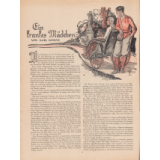
|
Article:
Worms, Karl, A Sick Girl (by Karl Worms, unknown author).
The drawing above shows a girl with long, blond hair in a wheelchair with a blanket over her legs in a park or garden. A young man in sporty knickerbockers leans against the wheelchair. Image without caption.
Drawing/illustration: "k" (Ernst Ludwig Kretschmann, 1897-1941).
[Page] 4
|
|
P. 5 |
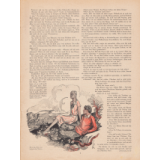
|
Article:
Worms, Karl, A Sick Girl (by Karl Worms, unknown author).
The drawing at the bottom left shows a young woman with long blonde hair sitting on a hill and looking into the distance. The young man from the previous page is leaning on a stone and looking at her. In the background is a mountain range and a small town. The caption reads "It is the picture of a colorful painter…".
Drawing/illustration: "k" (Ernst Ludwig Kretschmann, 1897-1941).
[Page] 5
|
|
P. 6 |

|
Article:
Scheu, Robert, My Experiences with Rafael Schermann (by Robert Scheu, 1873-1964);
Malkowsky, Emil Ferdinand, Spring Rush (by Emil Ferdinand Malkowsky, 1880-1967).
[Page] 6
|
|
P. 7 |
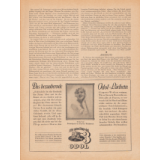
|
Article:
Scheu, Robert, My Experiences with Rafael Schermann (by Robert Scheu, 1873-1964);
N. N., Anecdote.
Advertising:
The enchanting Odol smile.
"Beauty is a gift of nature. But it is only in the art of preserving and enhancing it that the wisdom of the woman of our time is revealed." The charming blonde Gritta Ley made a very proud face when she revealed this secret. And then said with a laugh: "I just want to say that I don't just trust Lingner-Werke to look after my hair. Just as there is nothing else for my hair but Pixavon, I use nothing else for my mouth and teeth but the excellent Odol toothbrush, the wonderful Odol toothpaste and — last but not least — the indescribably pleasant Odol." And to prove it, Gritta Ley showed off her shimmering white pearl teeth with an enchanting smile.
[Photograph of] Gritta Ley [German actress, 1898-1986]. Winner of the Pixavon competition.
Perfect hygiene of the mouth and teeth includes: 1. the Odol toothbrush with its practical curved section. 2. the mild, fine-grained Odol toothpaste in the wonderful pure tin tube. 3. the wonderfully refreshing Odol, which disinfects the entire oral cavity and gives you fresh breath.
All good things come in threes: ODOL. Photo: Ortéga (unknown photographer).
[Page] 7
|
|
P. 8 |
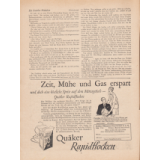
|
Article:
Worms, Karl, A Sick Girl (by Karl Worms, unknown author).
Advertising:
Save time, effort and gas and still have a delicious dish on the lunch table — Quaker Oats. The problem of the modern housewife: "How do I get a nutritious, tasty and yet cheap dish on the table in the shortest possible time that everyone will like!"
Now with Quaker Oats you save time, work and firing. Your menu is enriched with a tasty addition. And so quickly ready for the table — in just 3 to 5 minutes.
Fully ripe, golden yellow grains — they almost burst out of their shells — sun-soaked, rich in vitamins, proteins and carbohydrates, keep your body strong, lean and supple.
Clean in the box! No dusting! Free from husks! Every meal becomes tastier and more nutritious with the addition of Quaker Oats. Ask for a free sample, or ask your grocer for the 1 pound or ½ pound pack with the voucher for heavy silver cutlery.
Quaker Oats.
Recipe. Porridge: One part flakes, two parts water, stirred well, cooked for 3 to 5 minutes, served hot with cream, fruit juice or vanilla sugar.
Cut out! Send in!
Quaker Naehrmittel-Gesellschaft m. b. H., Dept. M 9, Elsen (Duesseldorf district). Please send me a free sample of Rapid Oats immediately.
Name: ______
Address: ______
Only valid in Germany. Drawing/illustration: unknown/unsigned.
[Page] 8
|



